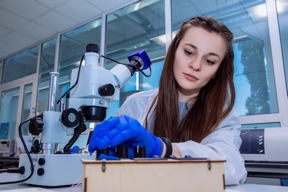Home > Press > IKBFU and University of Oviedo Physicists tested new research model on magnetic materials: Soft magnetic ferromagnetic microwires are used for magnetic field sensors, as well as for encoding and reading information
 |
| Valeria Kolesinkova |
Abstract:
Laboratory of Novice Magnet Materials working in collaboration with Spanish scientists (the University of Oviedo, Spain) tested the Preisach model using interfacing Fe-based microwires. This research was made to check whether it is applicable for FORC-analysis and how real-life conditions affect it.
IKBFU and University of Oviedo Physicists tested new research model on magnetic materials: Soft magnetic ferromagnetic microwires are used for magnetic field sensors, as well as for encoding and reading information
Kaliningrad, Russia | Posted on April 24th, 2020
Soft magnetic ferromagnetic microwires are used for magnetic field sensors, as well as for encoding and reading information. Such microwires are used, for example, for the implementation of 3D geolocation in gadgets, as well as for tagging commercial fish, etc.
The sensors mainly consist of a system containing several closely spaced microwires. This research issue is relevant, and several world scientific groups from different countries (Spain, Slovakia, Brazil, Russia) are engaged in these studies.
MA Student at “Functional nanomaterials and modern applications”, Valeria Kolesinkova:
“The FORC-analysis is one of the most well-known ways of magnet interaction analysis, based on the Preisach model, where the idea of a bistable microwire is introduced. To study various properties of magnetic (and not only) materials, we mainly use the well-known characterization methods, however, each method has its own applicability limits and this work shows the applicability limits of the method for analyzing magnetic interactions for ideal magnetic samples with bistable hysteresis loop. The study emphasizes the problems that can be encountered when working with this method in the framework of the Preisach model”.
###
The results of the research were published in the Journal of Magnetism and Magnetic Materials (Q2). The research was funded by the 5-top-100 IKBFU project.
####
For more information, please click here
Contacts:
Denis Zhigulin
7-913-322-9355
@IKBFU
Copyright © IKBFU
If you have a comment, please Contact us.
Issuers of news releases, not 7th Wave, Inc. or Nanotechnology Now, are solely responsible for the accuracy of the content.
News and information
![]() MOF material offers optical sensing of NO2 pollutant for air quality measurements April 30th, 2020
MOF material offers optical sensing of NO2 pollutant for air quality measurements April 30th, 2020
![]() Getting through the bottleneckA new class of layered perovskite with high oxygen-ion conductivity April 29th, 2020
Getting through the bottleneckA new class of layered perovskite with high oxygen-ion conductivity April 29th, 2020
![]() Fueling the World Sustainably: Synthesizing Ammonia using Less Energy April 26th, 2020
Fueling the World Sustainably: Synthesizing Ammonia using Less Energy April 26th, 2020
Magnetism
![]() A new strategy to create 2D magnetic order April 10th, 2020
A new strategy to create 2D magnetic order April 10th, 2020
![]() Magnet research takes giant leap April 10th, 2020
Magnet research takes giant leap April 10th, 2020
Possible Futures
![]() MOF material offers optical sensing of NO2 pollutant for air quality measurements April 30th, 2020
MOF material offers optical sensing of NO2 pollutant for air quality measurements April 30th, 2020
![]() Getting through the bottleneckA new class of layered perovskite with high oxygen-ion conductivity April 29th, 2020
Getting through the bottleneckA new class of layered perovskite with high oxygen-ion conductivity April 29th, 2020
![]() Fueling the World Sustainably: Synthesizing Ammonia using Less Energy April 26th, 2020
Fueling the World Sustainably: Synthesizing Ammonia using Less Energy April 26th, 2020
Chip Technology
![]() A new strategy to create 2D magnetic order April 10th, 2020
A new strategy to create 2D magnetic order April 10th, 2020
![]() Magnet research takes giant leap April 10th, 2020
Magnet research takes giant leap April 10th, 2020
Discoveries
![]() MOF material offers optical sensing of NO2 pollutant for air quality measurements April 30th, 2020
MOF material offers optical sensing of NO2 pollutant for air quality measurements April 30th, 2020
![]() Getting through the bottleneckA new class of layered perovskite with high oxygen-ion conductivity April 29th, 2020
Getting through the bottleneckA new class of layered perovskite with high oxygen-ion conductivity April 29th, 2020
![]() Fueling the World Sustainably: Synthesizing Ammonia using Less Energy April 26th, 2020
Fueling the World Sustainably: Synthesizing Ammonia using Less Energy April 26th, 2020
Announcements
![]() MOF material offers optical sensing of NO2 pollutant for air quality measurements April 30th, 2020
MOF material offers optical sensing of NO2 pollutant for air quality measurements April 30th, 2020
![]() Getting through the bottleneckA new class of layered perovskite with high oxygen-ion conductivity April 29th, 2020
Getting through the bottleneckA new class of layered perovskite with high oxygen-ion conductivity April 29th, 2020
![]() Fueling the World Sustainably: Synthesizing Ammonia using Less Energy April 26th, 2020
Fueling the World Sustainably: Synthesizing Ammonia using Less Energy April 26th, 2020
Interviews/Book Reviews/Essays/Reports/Podcasts/Journals/White papers/Posters
![]() MOF material offers optical sensing of NO2 pollutant for air quality measurements April 30th, 2020
MOF material offers optical sensing of NO2 pollutant for air quality measurements April 30th, 2020
![]() Getting through the bottleneckA new class of layered perovskite with high oxygen-ion conductivity April 29th, 2020
Getting through the bottleneckA new class of layered perovskite with high oxygen-ion conductivity April 29th, 2020
![]() Fueling the World Sustainably: Synthesizing Ammonia using Less Energy April 26th, 2020
Fueling the World Sustainably: Synthesizing Ammonia using Less Energy April 26th, 2020










